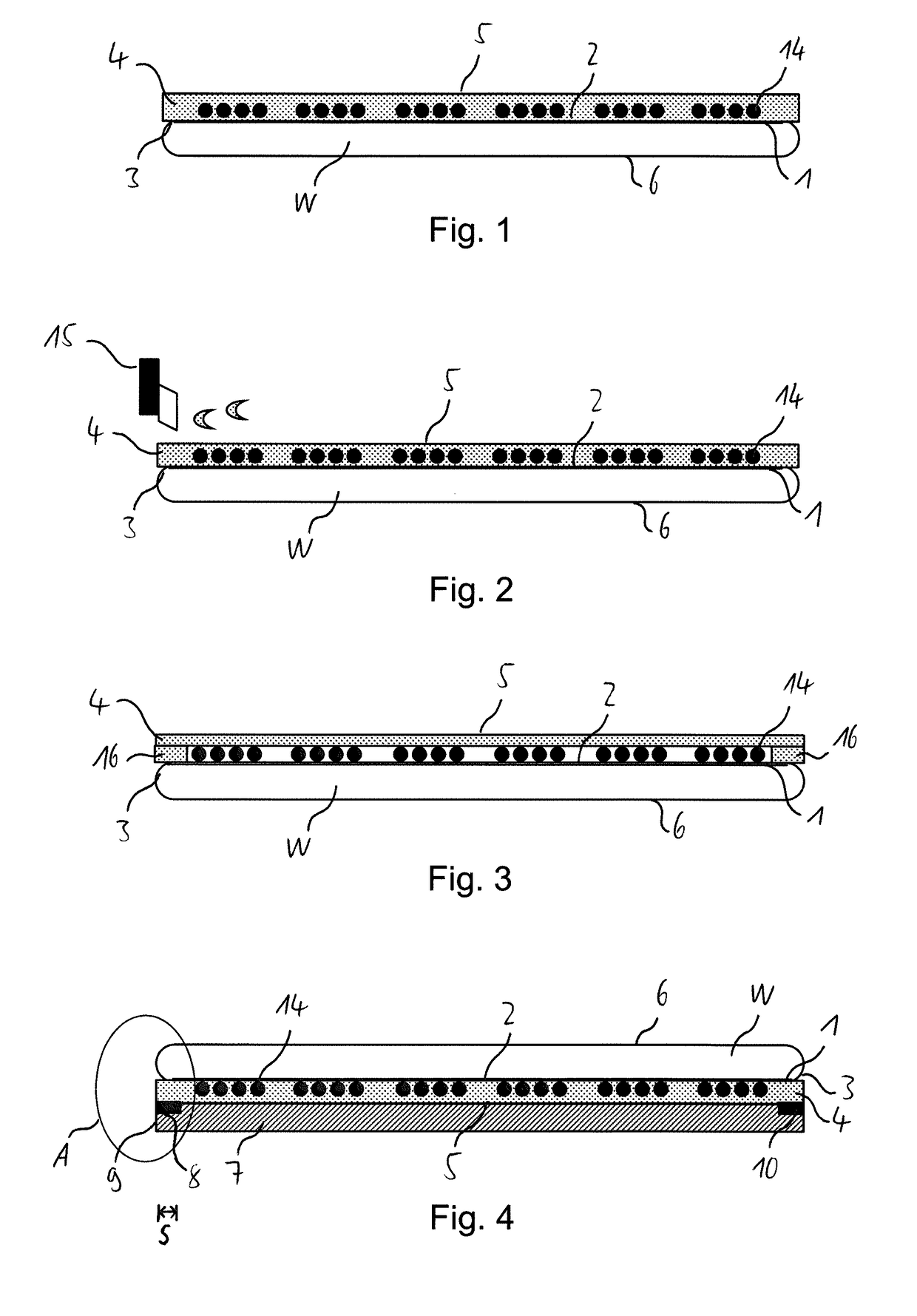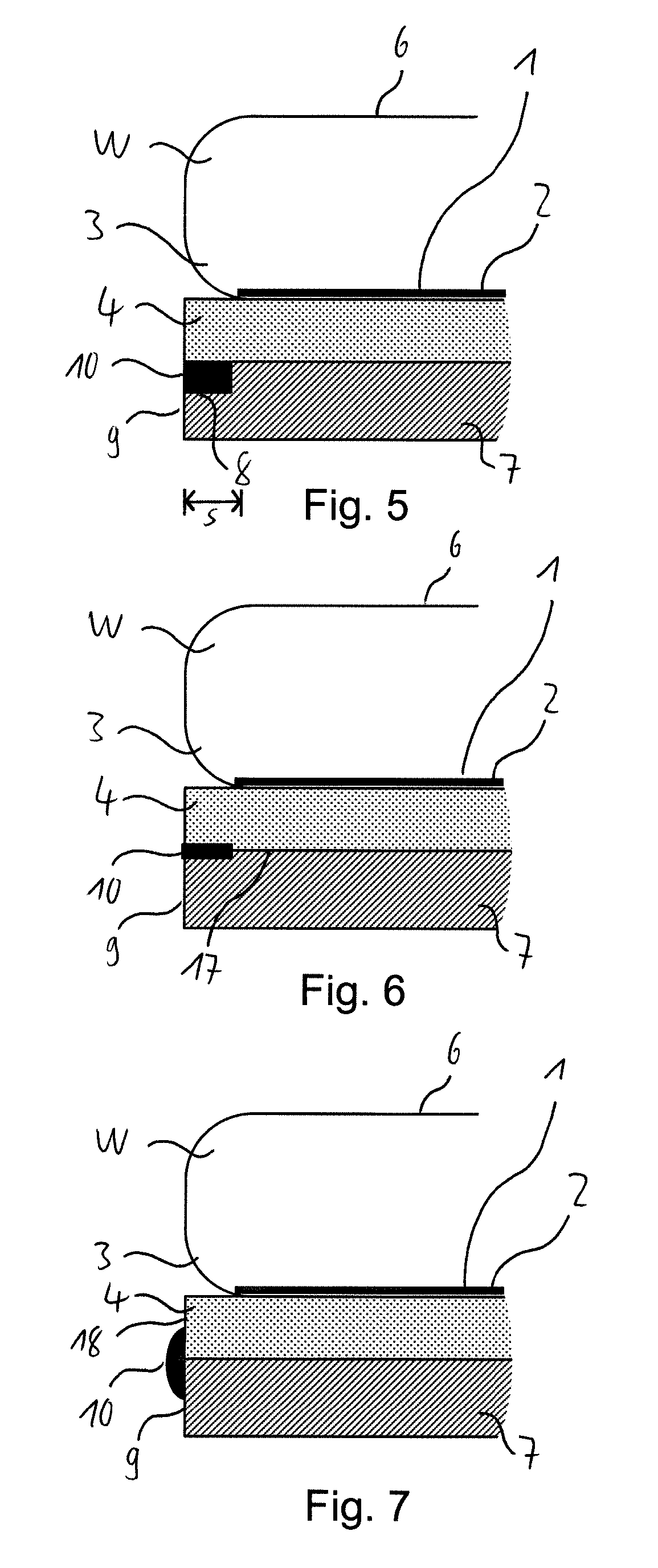Wafer dividing method
a technology of dividing method and wafer, which is applied in the direction of electrical apparatus, semiconductor devices, semiconductor/solid-state device details, etc., can solve the problems of limiting the number of devices which can be arranged on the wafer, reducing the efficiency of laser grooving process, and reducing the number of devices. the effect of a single, low cost and time-saving
- Summary
- Abstract
- Description
- Claims
- Application Information
AI Technical Summary
Benefits of technology
Problems solved by technology
Method used
Image
Examples
first embodiment
[0101]In the following, a method of dividing a wafer W according to the present invention will be described with reference to FIGS. 1 to 13.
[0102]FIG. 1 depicts the outcome of a first step of the method of dividing a wafer according to the first embodiment of the present invention. In this first step, an adhesive tape 4 is attached to the pattern side 1 of the wafer W. In other words, the pattern side 1 is laminated with the adhesive tape 4. The adhesive tape 4 preferably has the same shape as the wafer W and is attached thereto concentrically. When attached to the wafer W, the adhesive tape 4 adheres to the devices formed in the device area 2 of the pattern side 1.
[0103]The adhesive tape 4 allows for protection of the devices formed in the device area 2 of wafer W.
[0104]The adhesive of the adhesive tape 4 on the side thereof facing the pattern side 1 of the wafer W may be curable by an external stimulus, such as heat, UV radiation, an electric field and / or a chemical agent. In this...
second embodiment
[0140]Specifically, as is shown in FIG. 14, in the method of the second embodiment, the cutting of the wafer W is performed in seventh and eighth steps prior to the application of the protective layer 20.
[0141]Subsequently, as is schematically shown in FIG. 15, a liquid mold material for the protective layer is applied to the backside of the wafer W in a ninth step. The liquid mold material penetrates into the cuts 22 between the dies 23 created in the cutting process. Hence, the protective layer 20 can be reliably applied also to the side surfaces of the dies 23, thus providing particularly reliable protection.
[0142]The liquid mold material is curable by an external stimulus, such as heat, UV radiation, an electric field and / or a chemical agent. After the liquid mold material for the protective layer 20 has been applied to the backside of the wafer W, it is cured by applying the external stimulus thereto, e.g., by heating in an oven for the case of a heat curable, e.g., thermosetti...
third embodiment
[0153]In a thirteenth step of the third embodiment, the result of which is shown in FIG. 20, the carrier 7 and the adhesive tape 4 are removed from the wafer W. In particular, the adhesive of the adhesive tape 4 on the side thereof facing the pattern side 1 of the wafer W may be cured by applying an external stimulus thereto, as has been detailed above, so as to lower the adhesive force of the adhesive, thus allowing for an easy removal of the adhesive tape 4 and the carrier 7 from the wafer W.
[0154]Subsequently, the individual separated dies 23 can be picked up from the adhesive pick-up tape 24 by a pick-up device in the same manner as for the first and second embodiments. The spacing between the individual dies 23 can be increased by radially stretching the pick-up tape 24 in order to facilitate the pick-up process.
PUM
 Login to View More
Login to View More Abstract
Description
Claims
Application Information
 Login to View More
Login to View More - R&D
- Intellectual Property
- Life Sciences
- Materials
- Tech Scout
- Unparalleled Data Quality
- Higher Quality Content
- 60% Fewer Hallucinations
Browse by: Latest US Patents, China's latest patents, Technical Efficacy Thesaurus, Application Domain, Technology Topic, Popular Technical Reports.
© 2025 PatSnap. All rights reserved.Legal|Privacy policy|Modern Slavery Act Transparency Statement|Sitemap|About US| Contact US: help@patsnap.com



